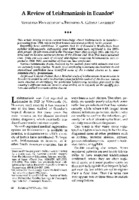Mostrar el registro sencillo del ítem
Cutaneous leishmaniasis in subtropical Ecuador: popular perceptions, knowledge, and treatment
| dc.contributor.author | Weigel, M.M | es_ES |
| dc.contributor.author | Armijos, R.X | es_ES |
| dc.contributor.author | Racines, R.J | es_ES |
| dc.contributor.author | Zurita, C | es_ES |
| dc.contributor.author | Izurieta, R | es_ES |
| dc.contributor.author | Herrera, E | es_ES |
| dc.contributor.author | Hinojsa, E | es_ES |
| dc.date.accessioned | 2016 | |
| dc.date.available | 2016 | |
| dc.date.issued | 1994 | es_ES |
| dc.identifier.uri | https://iris.paho.org/handle/10665.2/26942 | |
| dc.description.abstract | Popular perceptions and knowledge about cutaneous leishmaniasis and its treatment were studied in an endemic area of subtropical Northwest Ecuador. Although most of the adults surveyed were familiar with the disease, the vector, and traditional treatments, many showed a lack knowledge about transmission of the disease, ulcer healing, and conventional treatment. Gender was found to have a significant impact on disease risk, perceptions, and treatment knowledge. Males experienced a risk of contracting cutaneous leishmaniasis that was almost triple that of women. Men were also more likely to perceive that the disease seriously diminished the victim's capacity to work. Women, on the other hand were more prone to perceive that cutaneous leishmaniasis was a serious disease that significantly decreased self esteem. Although 80 percent of the subjects knew at least one method of treating the disease, women tended to know more methods than men. Most of 150 different therapies reported involved the use of indigenous plants, chemical, acids, antibiotics, heat treatments, or petroleum by products. Some of these treatments could have clinical value. However, only 7 percent of the subjects knew about pentavalent antimonials. Almost 70 percent of the subjects with a past or present infection history were treated solely by traditional methods; only 12 per cent received a full course of Glucantine, while 7.5 percent got an incomplete course. The findings indicate that it will be important to consider the identified gaps in knowledge and gender perceptions regarding the disease and its treatment when planning future control programms | en_US |
| dc.description.abstract | This article will also be published in Spanish in the BOSP. Vol. 117, 1994 | en_US |
| dc.format.extent | ilus | es_ES |
| dc.relation.ispartofseries | Bulletin of the Pan American Health Organization (PAHO);28(2),jun. 1994 | en_US |
| dc.subject | Leishmaniasis, Cutaneous | es_ES |
| dc.subject | Medicine, Traditional | es_ES |
| dc.subject | Tropical Climate | es_ES |
| dc.subject | Ecuador | es_ES |
| dc.title | Cutaneous leishmaniasis in subtropical Ecuador: popular perceptions, knowledge, and treatment | en_US |
| dc.type | Journal articles | en_US |
| dc.rights.holder | Pan American Health Organization | en_US |
Ficheros en el ítem
Este ítem aparece en la(s) siguiente(s) colección(ones)
-
Pan American Journal of Public Health
Revista Panamericana de Salud Pública



